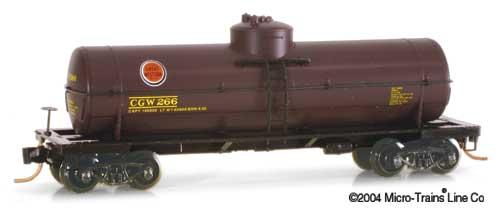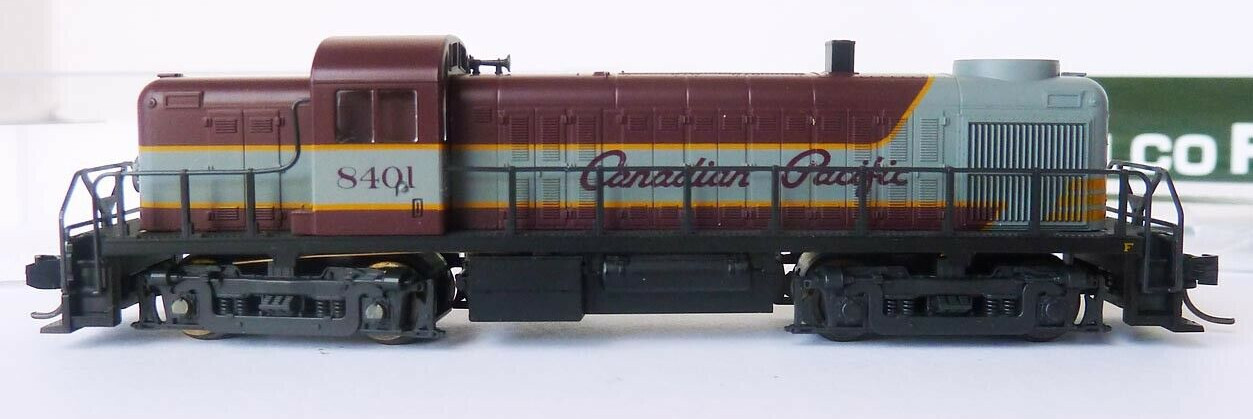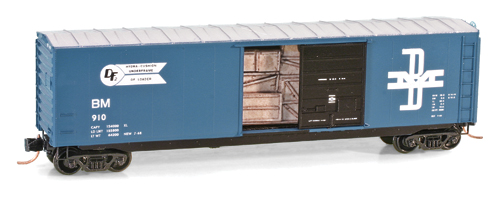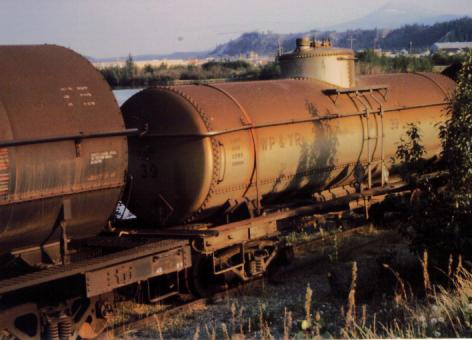Specific Item Information: Price from Micro-Trains Price List
Model Information: Dating back to 1979, this is the oldest and most popular of Micro-Trains tank cars. Over 200 different regular issues of this body style have been produced as well as hundreds more special runs, including the 2016 N Scale Enthusiast banquet car.
This car models tank cars of approximately 8,000 gallons. The prototypes were built in the 1950's and appeared on freight railroads across the United States and Canada.
This car models tank cars of approximately 8,000 gallons. The prototypes were built in the 1950's and appeared on freight railroads across the United States and Canada.
Prototype History: Single Dome tank cars are a railroad staple. They have been around since the first half of the 20th century. This length car can handle about 10,000 gallons. These railcars carry a wide array of commodities, including liquid fertilizers, chemicals, fuel oils and asphalt, and food-grade oils. Tank cars can be pressurized or non-pressurized, insulated or non-insulated. Single dome cars carry only a single commodity at once. Food-service tank cars may be lined with stainless steel, glass, or plastic. Tank cars carrying dangerous goods are generally made of different types of steel, depending on the intended cargo and operating pressure. They may also be lined with rubber or coated with specialized coatings for tank protection or product purity purpose. The tank heads are also stronger to prevent ruptures during accidents.
One common version is the ACF Type 27 jacketed tank car with expansion dome which was in common use by many railroads and oil companies.
One common version is the ACF Type 27 jacketed tank car with expansion dome which was in common use by many railroads and oil companies.
Road Name History: 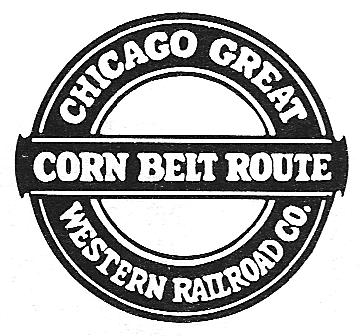 Chicago Great Western was the result of the 1892 reorganization of the Chicago St. Paul & Kansas City. By 1903, the CGW had grown to its maximum size. The CGW had a vaguely cross-shaped system map. The east-west leg started in Chicago and linked Dubuque, Fort Dodge (both in Iowa) and finally Omaha, Nebraska. The north-south line started in St. Paul, Minnesota and linked Waterloo and Des Moines, Iowa then St. Joseph and Kansas City, Missouri. Each axis consisted of a big arc which put CGW at a distance disadvantage to most other railroads servicing the same region – and there were a lot of railroads in the area.
Chicago Great Western was the result of the 1892 reorganization of the Chicago St. Paul & Kansas City. By 1903, the CGW had grown to its maximum size. The CGW had a vaguely cross-shaped system map. The east-west leg started in Chicago and linked Dubuque, Fort Dodge (both in Iowa) and finally Omaha, Nebraska. The north-south line started in St. Paul, Minnesota and linked Waterloo and Des Moines, Iowa then St. Joseph and Kansas City, Missouri. Each axis consisted of a big arc which put CGW at a distance disadvantage to most other railroads servicing the same region – and there were a lot of railroads in the area.
Passenger service was never a major priority and many trains consisted of doodlebugs and trailers even before World War One. In the 1920s CGW did team up with Santa Fe to run through sleepers from the Twin Cities to Los Angeles.
Big mainline power in the 30s and 40s consisted of a fleet of 3 dozen 2-10-4s. In 1936, CGW launched piggyback service – one of the first in the nation. One piggyback customer was a truck line specializing in hauling steel. Since CGW charged by the trailer, the truck line would take the contents of 3 trailers which had maxed out on highway weight and reload all the steel into a single catastrophically heavy trailer that would ride the flat car. They didn’t tell CGW though. No one was the wiser until the landing gear on a trailer punched through the deck of the flat car and derailed a train at speed!
By 1950, CGW had completely dieselized with a mix of Alco, Baldwin and EMD switchers, Alco and EMD road switchers (the former running long hood forward and the latter equipped with dual controls,) and a sizable fleet of EMD F units. By this time, the Deramus family (who already controlled the Kansas City Southern) had gained control of the CGW. Over the years, they cut costs and services. CGW began holding trains until they reached maximum tonnage. Trains between 150 and 250 cars were a daily occurrance behind A-B-B-B-B-A sets of F units. What’s more, these monsters would stop and switch along the way!
Around 1951, they dropped “The Corn Belt Route” logo in favor of the Lucky Strike style logo. The first generation of diesels were delivered in ornate maroon, and red with yellow striping. This was replaced with a simplified solid maroon and then red with black roof (which was essentially the same as neighbor and fellow Deramus controlled Kansas City Southern.) The second generation of diesels consisted entirely of GP30’s and SD40’s.
Despite the iffy service and tremendous competition in the area, and thanks to the cost cutting and a dearth of money losing passenger operations that plagued their neighbors, CGW steadily made money through the 50s and 60s. But, in the age of mergers, it was clear they couldn’t make it on their own. CGW discussed merger with every possible connection but ultimately merged into Chicago & North Western in 1968. In their last full year, the CGW was a 1,411 mile line with 139 locomotives (for comparison, they were about the same size as Western Pacific.)

Passenger service was never a major priority and many trains consisted of doodlebugs and trailers even before World War One. In the 1920s CGW did team up with Santa Fe to run through sleepers from the Twin Cities to Los Angeles.
Big mainline power in the 30s and 40s consisted of a fleet of 3 dozen 2-10-4s. In 1936, CGW launched piggyback service – one of the first in the nation. One piggyback customer was a truck line specializing in hauling steel. Since CGW charged by the trailer, the truck line would take the contents of 3 trailers which had maxed out on highway weight and reload all the steel into a single catastrophically heavy trailer that would ride the flat car. They didn’t tell CGW though. No one was the wiser until the landing gear on a trailer punched through the deck of the flat car and derailed a train at speed!
By 1950, CGW had completely dieselized with a mix of Alco, Baldwin and EMD switchers, Alco and EMD road switchers (the former running long hood forward and the latter equipped with dual controls,) and a sizable fleet of EMD F units. By this time, the Deramus family (who already controlled the Kansas City Southern) had gained control of the CGW. Over the years, they cut costs and services. CGW began holding trains until they reached maximum tonnage. Trains between 150 and 250 cars were a daily occurrance behind A-B-B-B-B-A sets of F units. What’s more, these monsters would stop and switch along the way!
Around 1951, they dropped “The Corn Belt Route” logo in favor of the Lucky Strike style logo. The first generation of diesels were delivered in ornate maroon, and red with yellow striping. This was replaced with a simplified solid maroon and then red with black roof (which was essentially the same as neighbor and fellow Deramus controlled Kansas City Southern.) The second generation of diesels consisted entirely of GP30’s and SD40’s.
Despite the iffy service and tremendous competition in the area, and thanks to the cost cutting and a dearth of money losing passenger operations that plagued their neighbors, CGW steadily made money through the 50s and 60s. But, in the age of mergers, it was clear they couldn’t make it on their own. CGW discussed merger with every possible connection but ultimately merged into Chicago & North Western in 1968. In their last full year, the CGW was a 1,411 mile line with 139 locomotives (for comparison, they were about the same size as Western Pacific.)
Brand/Importer Information: Micro-Trains is the brand name used by both Kadee Quality Products and Micro-Trains Line. For a history of the relationship between the brand and the two companies, please consult our Micro-Trains Collector's Guide.
Manufacturer Information:  Micro-Trains Line split off from Kadee Quality Products in 1990. Kadee Quality Products originally got involved in N-Scale by producing a scaled-down version of their successful HO Magne-Matic knuckle coupler system. This coupler was superior to the ubiquitous 'Rapido' style coupler due to two primary factors: superior realistic appearance and the ability to automatically uncouple when stopped over a magnet embedded in a section of track. The success of these couplers in N-Scale quickly translated to the production of trucks, wheels and in 1972 a release of ready-to-run box cars.
Micro-Trains Line split off from Kadee Quality Products in 1990. Kadee Quality Products originally got involved in N-Scale by producing a scaled-down version of their successful HO Magne-Matic knuckle coupler system. This coupler was superior to the ubiquitous 'Rapido' style coupler due to two primary factors: superior realistic appearance and the ability to automatically uncouple when stopped over a magnet embedded in a section of track. The success of these couplers in N-Scale quickly translated to the production of trucks, wheels and in 1972 a release of ready-to-run box cars.
Micro-Trains Line Co. split off from Kadee in 1990 to form a completely independent company. For this reason, products from this company can appear with labels from both enterprises. Due to the nature of production idiosyncrasies and various random factors, the rolling stock from Micro-Trains can have all sorts of interesting variations in both their packaging as well as the products themselves. When acquiring an MTL product it is very important to understand these important production variations that can greatly enhance (or decrease) the value of your purchase.
Please consult our Micro-Trains Collector's Guide

Micro-Trains Line Co. split off from Kadee in 1990 to form a completely independent company. For this reason, products from this company can appear with labels from both enterprises. Due to the nature of production idiosyncrasies and various random factors, the rolling stock from Micro-Trains can have all sorts of interesting variations in both their packaging as well as the products themselves. When acquiring an MTL product it is very important to understand these important production variations that can greatly enhance (or decrease) the value of your purchase.
Please consult our Micro-Trains Collector's Guide
Item created by: Lethe on 2015-05-31 17:46:30. Last edited by George on 2024-01-26 20:28:49
If you see errors or missing data in this entry, please feel free to log in and edit it. Anyone with a Gmail account can log in instantly.
If you see errors or missing data in this entry, please feel free to log in and edit it. Anyone with a Gmail account can log in instantly.


